Deng Tong, Jinse Finance
From repeated bearish predictions to breaking through $4,300, in just a few months since April, Ethereum has emerged from skepticism to the center of the crypto scene. What factors have driven Ethereum's surge? How high will ETH rise? What are the leading DeFi tokens worth watching?
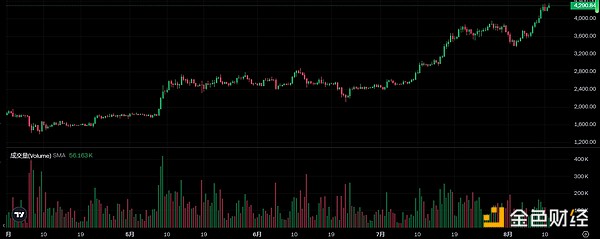
1. What factors have driven ETH's surge?
1. April: Favorable Regulation
In April 2025, ETH will enter a new upward trend. From its annual low of $1,385 on April 6th, it soared to $1,750 on April 23rd, a 26.3% increase, with the highest single-day gain exceeding 10%. This upward trend can be attributed to favorable regulations. On April 10th, the first US cryptocurrency bill came into effect. Trump signed legislation repealing a controversial IRS tax reporting rule targeting DeFi platforms, which had originally required DeFi protocols to send 1099 tax forms to users. The bill passed the Senate by a vote of 70 to 28 and the House of Representatives by a vote of 292 to 132, making it the first US bill specifically targeting cryptocurrency. The bill's implementation boosted industry confidence, with DeFi's value locked (TVL) increasing 4.2% in a week to $46.7 billion. On April 24, the Federal Reserve announced the complete withdrawal of its 2022 regulatory guidance for banks' crypto assets and dollar token businesses, abolished the 2023 "regulatory no-objection" process, and withdrew from the crypto asset risk policy statement jointly issued with the Federal Deposit Insurance Corporation (FDIC) and the Office of the Comptroller of the Currency (OCC). This move marks the end of Operation Choke Point 2.0, the US's heavy-handed regulatory policy on the crypto industry. Banks can once again provide accounts and payment channels to crypto companies. Institutions such as Circle, the issuer of the stablecoin USDC, have stated their commitment to accelerating cross-border payments and DeFi applications. 2. May - Today: Pectra Upgrade and Ethereum Treasury Reserve Trend On May 7, Ethereum successfully implemented the Pectra upgrade, the most significant network update since the 2022 merge. This hard fork includes 11 EIPs, focusing on three key areas: improving staking efficiency, optimizing user experience, and enhancing Layer 2 scalability. The successful deployment of the Hoodi testnet in March laid the foundation for this upgrade. Pectra also lays the foundation for the Fusaka upgrade, which will introduce key technologies such as Verkle Trees and PeerDAS.
The most notable feature of this upgrade is EIP-7702, the account abstraction scheme, which allows ordinary wallets to temporarily execute smart contract functions. This will enable innovative user experiences such as third-party gas fee payment, batched transaction processing, and even the recovery of lost private keys through social contacts. Regarding the staking mechanism, the ETH staking limit for a single validator node has been significantly increased from 32 to 2,048, allowing institutional stakers to reduce operational complexity through node consolidation. Regarding Layer 2 scaling, the blob data capacity per block has doubled to 6 (peaking at 9). Since May, several companies have announced plans for Ethereum treasuries. On May 27, SharpLink Gaming announced it had signed a securities purchase agreement for a $425 million private placement (PIPE) of its common stock (or equivalents) at a price of $6.15 per share (or $6.72 per share for management team members). SharpLink Gaming will use the raised funds to purchase ETH as the company's primary treasury reserve asset. On May 31, the board of directors of Mega Matrix Inc., a New York Stock Exchange-listed company, approved Bitcoin and Ethereum as treasury reserve assets. On June 26, Bit Digital, a US-listed company, announced a strategic transformation, planning to gradually cease Bitcoin mining operations and gradually convert its BTC holdings into ETH, focusing on Ethereum staking and asset allocation, becoming a "pure Ethereum staking and treasury company." On July 9, GameSquare Holdings, Inc. announced that its board of directors had approved the phased establishment of an Ethereum treasury, with a total amount of up to $100 million. On July 22, BitMine announced that ARK Invest had acquired 4,773,444 shares of BitMine common stock (BMNR), valued at $182 million. BitMine plans to use all net proceeds (approximately US$177 million) to purchase ETH;
On July 26, Sandclock, a decentralized wealth management platform that supports access to insurance and SOC-2 certified on-chain, announced the launch of its ETH treasury strategy;
On July 30, Fundamental Global Inc., a Nasdaq-listed company, announced the sale of 40 million common shares at US$5 per share, with expected total proceeds of US$200 million, which will be used to launch the company's Ethereum treasury strategy;
On August 5, 180 Life Sciences Corp. (ETHZilla), a Nasdaq-listed company, announced the completion of a US$425 million private placement and the official launch of its ETH treasury strategy;
On August 10, Huajian Medical announced that it has officially launched the "Global Enhanced Ethereum Treasury with Downside Protection Mechanism" strategy.
In response to the trend of many companies establishing Ethereum treasuries, 1confirmation founder Nick Tomaino stated in a statement that 1confirmation fully supports ETH, saying that without Ethereum, the crypto industry cannot continue to develop. The innovative values of trusted neutrality, open source, and permissionless development must be promoted. The crypto industry is currently focusing on venture capital chains and corporate crypto treasuries. While this trend is not closely related to Ethereum's values, it is not necessarily a bad thing. Companies establishing ETH treasuries may be a good thing. As crypto pioneer Hal Finney said 33 years ago, "Computers should be tools to liberate and protect humanity, not to control it."
3. July: Trump Signs the GENIUS Act, Crypto Week Begins
On July 19th, the US House of Representatives passed the stablecoin bill, and US President Trump officially signed the "Guiding and Establishing a National Innovation Act for Stablecoins in the United States" (GENIUS Act) at the White House, marking the implementation of US stablecoin regulatory legislation and a turning point for the cryptocurrency industry. Most stablecoins are issued and traded on the Ethereum blockchain. The increasing use of dollar-pegged stablecoins has boosted demand for ETH, used to pay transaction fees. The White House issued a statement praising the passage of the GENIUS Act, calling it historic legislation that will pave the way for the United States to lead the global digital currency revolution. President Trump said the bill "creates a clear and concise regulatory framework to establish and unleash the enormous potential of dollar-backed stablecoins. This is perhaps the greatest revolution in financial technology since the birth of the internet." From July 14th to 18th, the U.S. House Financial Services Committee launched "Crypto Week." Legislators debated and voted on three major crypto bills: the CLARITY Act, which defines regulatory oversight of the crypto market; the GENIUS Act, which establishes a framework for stablecoins and has already passed the Senate; and the Anti-CBDC Surveillance State Act, which would prohibit the creation of a US central bank digital currency. "Crypto Week" not only brought short-term positive news to the crypto market, but in the long term, increased regulatory certainty will attract more institutional capital, pushing mainstream cryptocurrencies like Bitcoin into a "slow bull market." Meanwhile, niche sectors like DeFi and NFTs may see a surge in innovation due to the exemptions provided by the CLARITY Act. On July 29th, the US SEC officially approved the "physical subscription and redemption" mechanism for Bitcoin and Ethereum spot ETFs, covering products from multiple institutions including BlackRock, Ark21, Fidelity, VanEck, and Franklin Templeton. This adjustment will make fund operations more efficient and reduce costs.
The SEC also approved applications for a fund of funds that includes Bitcoin and Ethereum spot assets, a Bitcoin ETF options product, and the relaxation of some options position limits. Chairman Paul Atkins called this move "part of establishing a more rational regulatory framework" that will contribute to the depth and vitality of the US crypto market.
4. August: SEC Guidance on Liquidity Pledge
On August 5, the U.S. Securities and Exchange Commission staff issued guidance on liquidity staking.Under certain conditions, liquidity staking activities and the resulting receipt tokens do not constitute securities offerings. Mara Schmiedt, CEO of blockchain development company Alluvial, noted, "Institutions can now confidently integrate LST into their products, which will undoubtedly generate new revenue streams, expand their customer base, and create a secondary market for staked assets. This decision lays the foundation for a wave of new products and services that will accelerate mainstream participation in the digital asset market." This wave of institutional adoption may help retail traders and influence institutions to provide DeFi services.
How high will ETH rise?
As ETH's upward trend continues, whales are voting with their feet.
According to on-chain analyst Yu Jin, Since July 10, more than 1.1 million ETH (approximately US$4.78 billion) has been hoarded by multiple unknown whales/institutions through trading platforms or institutional business platforms. The average price of these hoarded ETH is approximately US$3,584. During this period, the price of ETH rose from US$2,600 to US$4,300, a 65% increase.
In the past 24 hours, Arthur Hayes has increased his holdings of ETH and a variety of DeFi blue-chip assets, including 1,500 ETH (worth approximately US$6.35 million), 425,000 LDO (worth approximately US$557,000), 420,000 ETHFI (worth approximately US$517,000) and 185,000 PENDLE (worth approximately US$1.02 million).
Analysts' predictions for ETH's future price are as follows:
Analyst Merlijn said that ETH's price rise channel has opened, and the current highest target price may be set at $20,000.
Trader BitBull pointed out that driven by large-scale short squeezes and institutional buying, ETH prices may be more likely to hit new historical highs. If the weekly closing price is above the $4,100 range, a new historical high may appear within 1-2 weeks.
Analyst Lord Hawkins said that Ethereum is showing signals of breaking through its current Wyckoff accumulation pattern. According to Wyckoff theory, once buyers gain control, this phase typically culminates in a decisive breakout. This breakout appears to be underway, with ETH breaking through the $4,200 resistance zone, a phase known as a "sign of strength" (SOS). In Wyckoff's model, this is often followed by a brief pullback, or "last point of support" (LPS), to confirm a new uptrend. If the LPS holds, the price will enter an upward phase, accelerating as demand outstrips supply. Measuring the height of the accumulation range, the technical target is near $6,000. Crypto Rover and Titan analysts report that as of Sunday, ETH had broken through the upper trendline of its multi-year symmetrical triangle, located in the $4,000-4,200 range. The breakout signals potential price action equal in magnitude to the triangle's highest point and points to a move above the $8,000 region in the coming months. Analyst Nilesh Verma highlighted a repeating pattern in which ETH rebounds sharply after retesting major bottoming support levels. ETH repeated this same "bottom retest" pattern in April 2025, rebounding strongly from the $1,750-$1,850 range. The ongoing rally could continue until April 2026, with the fractal's robust target at "minimum $10,000" and, in a best-case scenario, $20,000.
III. Leading DeFi Tokens Worth Watching
Arthur_0x, founder and CIO of DeFiance Capital, posted on social media, stating that Ethereum's rise is like a rising tide, driving many projects in the decentralized finance (DeFi) space, while Bitcoin's gains are more isolated. It is expected that top DeFi projects will see a series of major developments in the near future.
The following are DeFi tokens worth watching.
1. Lido Finance (LDO)
As Ethereum's largest liquid staking protocol, Lido holds 25% of the staking market share. Its price has risen 58.3% in the past seven days and is currently trading at $1.48.
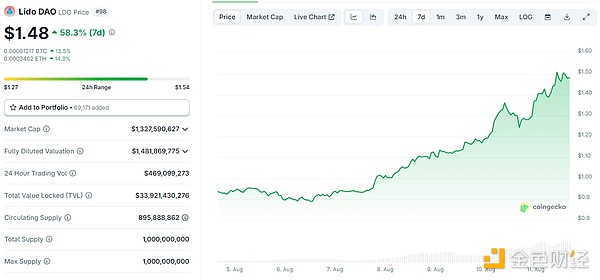
Recent good news:
The EU MiCA Act entered the second phase of implementation in July 2025. As one of the first liquidity pledge agreements to pass MiCA certification, Lido has obtained the qualification of "systemically important stablecoin service provider"; in July 2025, a proposal was passed to invest 20,000 ETH in the vault into Pendle's fixed income vault, locking in an annualized return of 6.2%, which not only optimized the efficiency of fund use, but also released a signal of long-term value holding to the market; on August 1, 2025, the Monetary Authority of Singapore (MAS) approved Lido , allowing it to conduct cross-border settlements through stETH, meaning stETH can enter the traditional financial system as a compliant asset.
2. Ether.fi (ETHFI)
Ether.fi is the first native liquidity staking protocol on EigenLayer. It allows users to stake ETH or other LST (such as stETH) to obtain eETH and earn additional returns by re-staking on EigenLayer. Currently trading at $1.26, it has risen 6.5% in the past 24 hours.
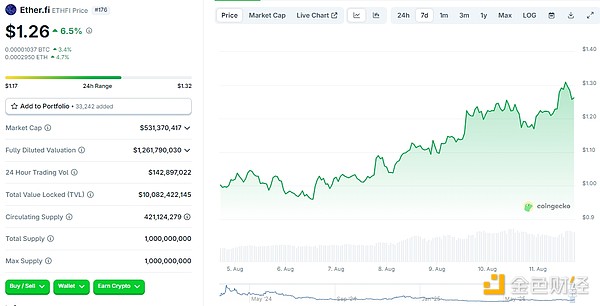
Recent Good News:
Ether.fi's total locked value reached $4.9 billion at the beginning of 2025 and exceeded $6.2 billion in August, a year-on-year increase of 126%.
In July, the ether.fi community voted to approve the "Deploy ETHFI Staking Contract" proposal with a 99.5% approval rate. The proposal seeks approval to deploy the ETHFI staking contract on the Ethereum mainnet. The ETHFI staking mechanism aims to provide real utility by tying rewards to governance participation and effective balance within the ecosystem. The staking contract will include future incentives and voting functionality for staked tokens. 3. Pendle (PENDLE) Pendle is a yield trading protocol focused on interest-bearing assets. By separating principal and interest from interest-bearing assets, it aims to provide users with interest rate trading tools for risk management and yield optimization. Currently trading at $5.34, it has risen 1.9% in the past 24 hours.
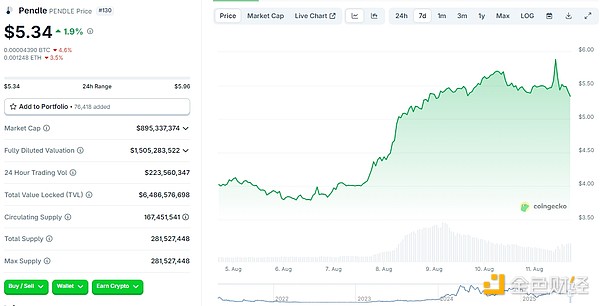
Recent Good News:
On August 6th, the Pendle team launched Boros, a funding rate trading platform on Arbitrum. Users can speculate and hedge on funding rates through this platform. The platform currently supports trading Binance BTCUSDT and ETHUSDT funding rates, and plans to expand to more assets (such as SOLUSDT, BNBUSDT), more platforms (such as Hyperliquid, Bybit), more maturities, and more yield products in the future. Boros uses Yield Units (YUs) for trading. Each YU represents the yield of one unit of collateralized asset until maturity, similar to Pendle's YT. Pendle's TVL exceeded $8 billion in August, with Ethereum contributing $7.41 billion. DeFi Llama data shows it holds 58% of the market share in the yield-generating sector, five times that of the next largest. 4. Uniswap (UNI) Uniswap uses an automated market maker (AMM) mechanism to facilitate asset exchange. Uniswap automatically matches trades through a liquidity pool, rather than relying on order books and centralized matching. Currently trading at $11.04, it's up 3.3% in the past 24 hours.
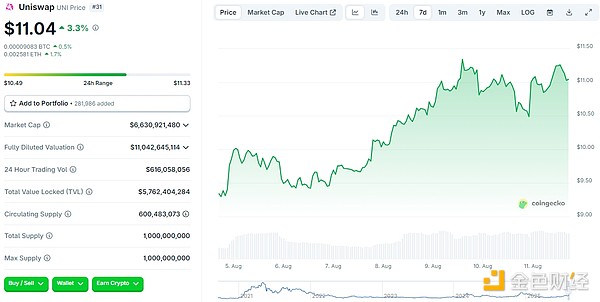
Recent Good News:
According to Dune data, the Uniswap protocol has completed 719,951,542 transactions since 2025, setting a new annual record.
On June 13th, Uniswap Labs announced that Uniswap Wallet users can now enable the Smart Wallet feature, unlocking one-click swaps by bundling transactions, supporting smarter swaps and lowering costs. New wallets created on the Uniswap mobile app or browser extension will default to the Smart Wallet. Future features will include gas sponsorship and the ability to pay gas fees with any token. 5. Convex Finance (CVX) Convex Finance primarily serves Curve Finance's liquidity providers and CRV token holders, acting as a yield optimizer for the Curve protocol. CVX is currently trading at $4.69, up 3.6% in the past 24 hours. Recent Good News: In June 2025, Convex and Frax Finance reached a strategic partnership to jointly launch a CVX-based stablecoin vault, offering users an 8.5% annualized return and rapidly exceeding $45 billion in assets under management. Convex continues to expand its presence on Ethereum Layer 2 networks (such as Arbitrum and Optimism), with the TVL of its cross-chain liquidity pool increasing by 39% in the second quarter of 2025.
6. AAVE
AAVE is a decentralized, non-custodial liquidity market protocol that allows users to borrow and lend crypto assets without an intermediary. It's currently trading at $305.29, up 0.4% over the past 24 hours.
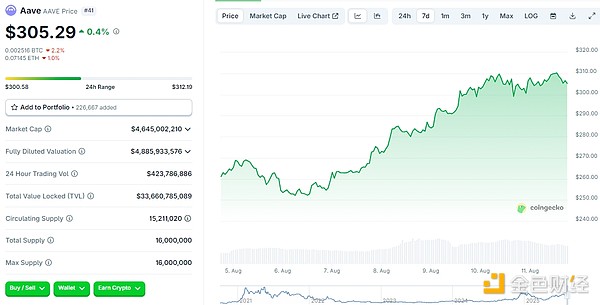
Recent Good News:
On August 8th, Aave partnered with Plasma to launch an institutional incentive fund. This fund aims to incentivize fintech companies and institutions to migrate their businesses to the blockchain and build a new financial system based on Plasma. On August 7, Aave’s total deposits reached $60 billion, a record high for the protocol.
 Kikyo
Kikyo











